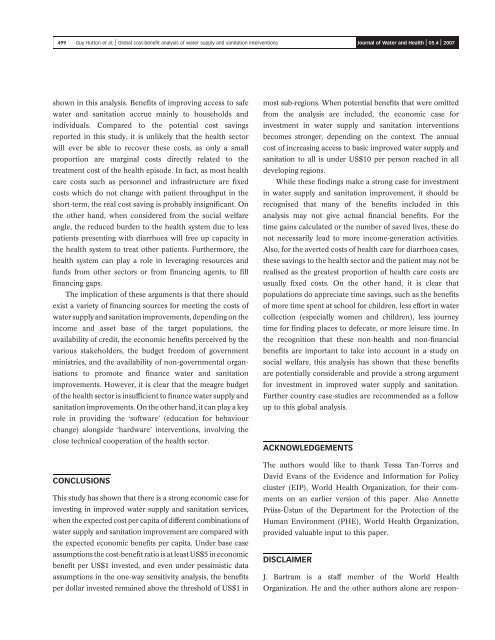Global cost-benefit analysis of water supply and sanitation ... - SuSanA
Global cost-benefit analysis of water supply and sanitation ... - SuSanA
Global cost-benefit analysis of water supply and sanitation ... - SuSanA
You also want an ePaper? Increase the reach of your titles
YUMPU automatically turns print PDFs into web optimized ePapers that Google loves.
499 Guy Hutton et al. | <strong>Global</strong> <strong>cost</strong>-<strong>benefit</strong> <strong>analysis</strong> <strong>of</strong> <strong>water</strong> <strong>supply</strong> <strong>and</strong> <strong>sanitation</strong> interventions Journal <strong>of</strong> Water <strong>and</strong> Health | 05.4 | 2007<br />
shown in this <strong>analysis</strong>. Benefits <strong>of</strong> improving access to safe<br />
<strong>water</strong> <strong>and</strong> <strong>sanitation</strong> accrue mainly to households <strong>and</strong><br />
individuals. Compared to the potential <strong>cost</strong> savings<br />
reported in this study, it is unlikely that the health sector<br />
will ever be able to recover these <strong>cost</strong>s, as only a small<br />
proportion are marginal <strong>cost</strong>s directly related to the<br />
treatment <strong>cost</strong> <strong>of</strong> the health episode. In fact, as most health<br />
care <strong>cost</strong>s such as personnel <strong>and</strong> infrastructure are fixed<br />
<strong>cost</strong>s which do not change with patient throughput in the<br />
short-term, the real <strong>cost</strong> saving is probably insignificant. On<br />
the other h<strong>and</strong>, when considered from the social welfare<br />
angle, the reduced burden to the health system due to less<br />
patients presenting with diarrhoea will free up capacity in<br />
the health system to treat other patients. Furthermore, the<br />
health system can play a role in leveraging resources <strong>and</strong><br />
funds from other sectors or from financing agents, to fill<br />
financing gaps.<br />
The implication <strong>of</strong> these arguments is that there should<br />
exist a variety <strong>of</strong> financing sources for meeting the <strong>cost</strong>s <strong>of</strong><br />
<strong>water</strong> <strong>supply</strong> <strong>and</strong> <strong>sanitation</strong> improvements, depending on the<br />
income <strong>and</strong> asset base <strong>of</strong> the target populations, the<br />
availability <strong>of</strong> credit, the economic <strong>benefit</strong>s perceived by the<br />
various stakeholders, the budget freedom <strong>of</strong> government<br />
ministries, <strong>and</strong> the availability <strong>of</strong> non-governmental organisations<br />
to promote <strong>and</strong> finance <strong>water</strong> <strong>and</strong> <strong>sanitation</strong><br />
improvements. However, it is clear that the meagre budget<br />
<strong>of</strong> the health sector is insufficient to finance <strong>water</strong> <strong>supply</strong> <strong>and</strong><br />
<strong>sanitation</strong> improvements. On the other h<strong>and</strong>, it can play a key<br />
role in providing the ‘s<strong>of</strong>tware’ (education for behaviour<br />
change) alongside ‘hardware’ interventions, involving the<br />
close technical cooperation <strong>of</strong> the health sector.<br />
CONCLUSIONS<br />
This study has shown that there is a strong economic case for<br />
investing in improved <strong>water</strong> <strong>supply</strong> <strong>and</strong> <strong>sanitation</strong> services,<br />
when the expected <strong>cost</strong> per capita <strong>of</strong> different combinations <strong>of</strong><br />
<strong>water</strong> <strong>supply</strong> <strong>and</strong> <strong>sanitation</strong> improvement are compared with<br />
the expected economic <strong>benefit</strong>s per capita. Under base case<br />
assumptions the <strong>cost</strong>-<strong>benefit</strong> ratio is at least US$5 in economic<br />
<strong>benefit</strong> per US$1 invested, <strong>and</strong> even under pessimistic data<br />
assumptions in the one-way sensitivity <strong>analysis</strong>, the <strong>benefit</strong>s<br />
per dollar invested remained above the threshold <strong>of</strong> US$1 in<br />
most sub-regions. When potential <strong>benefit</strong>s that were omitted<br />
from the <strong>analysis</strong> are included, the economic case for<br />
investment in <strong>water</strong> <strong>supply</strong> <strong>and</strong> <strong>sanitation</strong> interventions<br />
becomes stronger, depending on the context. The annual<br />
<strong>cost</strong> <strong>of</strong> increasing access to basic improved <strong>water</strong> <strong>supply</strong> <strong>and</strong><br />
<strong>sanitation</strong> to all is under US$10 per person reached in all<br />
developing regions.<br />
While these findings make a strong case for investment<br />
in <strong>water</strong> <strong>supply</strong> <strong>and</strong> <strong>sanitation</strong> improvement, it should be<br />
recognised that many <strong>of</strong> the <strong>benefit</strong>s included in this<br />
<strong>analysis</strong> may not give actual financial <strong>benefit</strong>s. For the<br />
time gains calculated or the number <strong>of</strong> saved lives, these do<br />
not necessarily lead to more income-generation activities.<br />
Also, for the averted <strong>cost</strong>s <strong>of</strong> health care for diarrhoea cases,<br />
these savings to the health sector <strong>and</strong> the patient may not be<br />
realised as the greatest proportion <strong>of</strong> health care <strong>cost</strong>s are<br />
usually fixed <strong>cost</strong>s. On the other h<strong>and</strong>, it is clear that<br />
populations do appreciate time savings, such as the <strong>benefit</strong>s<br />
<strong>of</strong> more time spent at school for children, less effort in <strong>water</strong><br />
collection (especially women <strong>and</strong> children), less journey<br />
time for finding places to defecate, or more leisure time. In<br />
the recognition that these non-health <strong>and</strong> non-financial<br />
<strong>benefit</strong>s are important to take into account in a study on<br />
social welfare, this <strong>analysis</strong> has shown that these <strong>benefit</strong>s<br />
are potentially considerable <strong>and</strong> provide a strong argument<br />
for investment in improved <strong>water</strong> <strong>supply</strong> <strong>and</strong> <strong>sanitation</strong>.<br />
Further country case-studies are recommended as a follow<br />
up to this global <strong>analysis</strong>.<br />
ACKNOWLEDGEMENTS<br />
The authors would like to thank Tessa Tan-Torres <strong>and</strong><br />
David Evans <strong>of</strong> the Evidence <strong>and</strong> Information for Policy<br />
cluster (EIP), World Health Organization, for their comments<br />
on an earlier version <strong>of</strong> this paper. Also Annette<br />
Prüss-Üstun <strong>of</strong> the Department for the Protection <strong>of</strong> the<br />
Human Environment (PHE), World Health Organization,<br />
provided valuable input to this paper.<br />
DISCLAIMER<br />
J. Bartram is a staff member <strong>of</strong> the World Health<br />
Organization. He <strong>and</strong> the other authors alone are respon-
















